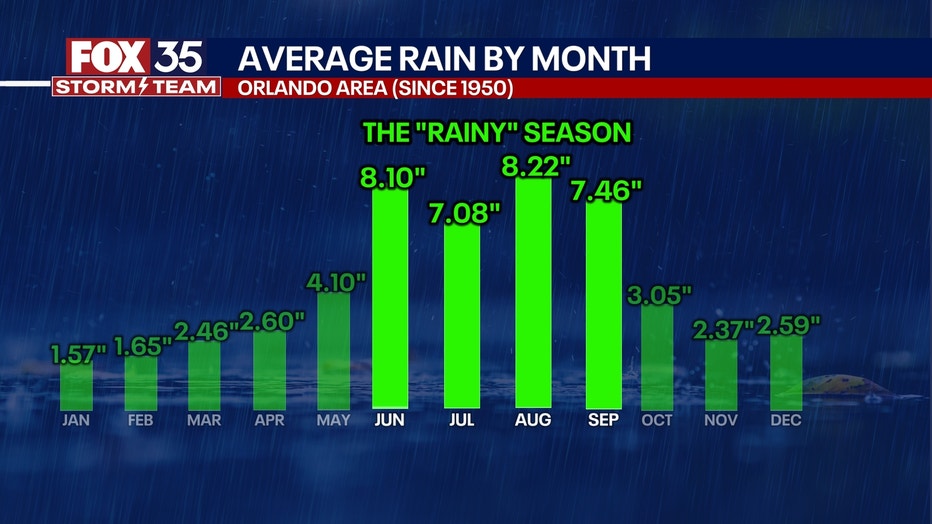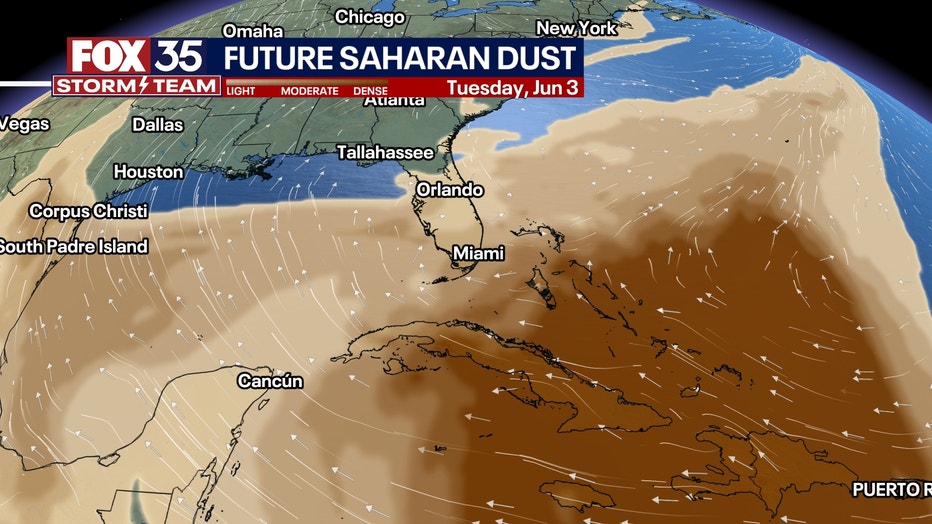Florida rainy season: When does it start and end? Why does it rain in the afternoon?
ORLANDO, Fla. - As summer approaches – along with the start of hurricane season — it may seem that it suddenly rains every afternoon in Central Florida, almost like it's scheduled. Welcome to Florida's rainy season.
Where does this rain come from? Why does it rain? How long does it last? And why does it suddenly just stop?
Let's break it down.
When does Florida's rainy season start? And when does it end?

The rainy season — also known as the wet season – in Florida typically begins in late May. And it usually lasts for about five months, typically clearing out by mid-October.
The average start day is May 24 for Orlando and May 27 for Daytona Beach, based on decades of weather data.
During the rainy season, it tends to rain or thunderstorm in the afternoon and evening hours. In fact, places like Orlando receive more than half its yearly rainfall total during this period – about 61%.

Why does it rain in the afternoon? Blame the sea breeze

This weather pattern is driven by Florida's unique sea breeze system.
As the sun heats the land more quickly than the surrounding ocean, air rises over land. Cooler, moist air from the Atlantic and Gulf rushes in to replace it, forming sea breezes. These breezes collide over the Florida peninsula in the afternoon, causing air to rise rapidly, condense, and form thunderstorms — usually between 4 and 6 p.m. when the heat is at its peak.
Sometimes the rain is in and out – and sometimes it will last hours. It will vary each day.

When does the rainy season end?
The rainy season doesn’t slam to a halt overnight, though it may seem like it. When it does, it's usually because of one key ingredient: cold fronts. In October, cooler and drier air masses from the north begin pushing down into the Southern U.S. — and Florida.
These cold fronts:
- Drop dew points (the measure of humidity)
- Lowers overnight temperatures
- Drier air disrupts the sea breeze cycle, which chokes off the fuel for those afternoon storms
Dry Season Begins
On average, the "dry" season begins around October 15. However, in some years it may stretch later if tropical systems or unusual weather patterns sneak in.
Does the Saharan Dust impact the rain in Florida?

Yes—and it’s not just a curiosity.
Saharan dust, blown across the Atlantic from Africa, can influence Florida’s rainy season in two key ways:
Dry Air Suppression: This dust-laden air is incredibly dry. When it mixes into our atmosphere, it can stop cloud formation and limit thunderstorms, even during the peak of the rainy season.
Storm Structure Changes: When a thunderstorm does form in the presence of dry air, it can intensify downward winds, called downdrafts. These can produce damaging wind gusts as dry air is "entrained" – or drawn – into the storm, causing rapid cooling and pushing air down fast. So, that hazy sky may look harmless, but it’s often a clue that storm dynamics are shifting.

Saharan dust tracks toward Florida
Saharan dust is headed to Florida. It travels to the Sunshine State each summer, causing hazy skies, colorful sunsets, and lower air quality. The dry, dusty air can weaken or block hurricane formation.
Does this happen anywhere else?
Florida is largely unique in its regularity of the two sea breezes colliding. But in the Central Yucatán Peninsula of Mexico, there too exists the daily dance of converging sea breezes in what mirrors what happens in Florida.
Interestingly enough, Florida and Mexico share the same body of water and are in the same general region of the world. However, instead of the Gulf and Atlantic sea breezes, the Yucatan experiences the colliding of the Gulf and Caribbean sea breeze. These downpours usually peak near sunset.
While many tropical coastal regions experience sea breeze-driven storms as the ocean air pushes inland and rises into warm, humid atmospheres, Florida is uniquely positioned. Thanks to its narrow peninsula shape, warm waters on both sides, and flat terrain, it's one of the only places on Earth where the collision of two sea breezes is the main engine behind the entire wet season—a rare and powerful dynamic not seen in most other climates.
Final Thought
Florida’s wet and dry seasons are driven by science, not just soggy shoes or sunburns. From sea breezes to Saharan dust, these patterns help define life in the Sunshine State—and offer clues about what weather to expect next.
The Source: The information in this article comes from FOX 35 meteorologist Brooks Garner, data and records from the National Weather Service and NOAA, and high-tech meteorological data systems.

